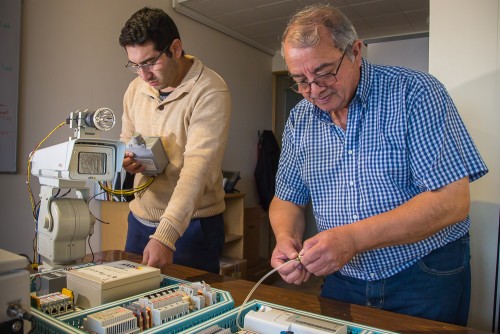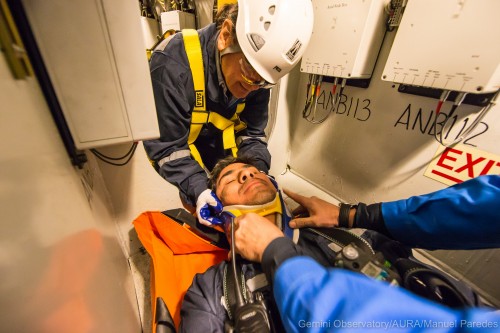
Gemini’s Assistant Engineer Francisco Meza and Electronics Technician Herman Diaz, work on control boxes for cloud cameras and fog weather sensors. These are part of the environmental monitoring work-package within the Base Facility Operations (BFO) project at Gemini South.
Base Facility Operations Status
Gemini South is integrating a new Base Facility Operations (BFO) system to allow nightly operations from the base facilities in La Serena.
The goal of the BFO project is to provide the infrastructure to safely perform telescope operations from the base facilities (Gemini North is already operating routinely in this mode), with new tools for remote assessment, notification and control of telescope systems, instruments and support infrastructure. This includes monitoring and assessment tools for weather, earthquake and network connectivity, as well as improvements and upgrades to the existing systems related to the needs for safe operations from the base facility.
The final project handover for BFO is scheduled for December of this year, with many milestones on the horizon.
In June and July the Facility Protection System (FPS) and the Telescope System Remote Switch (TSRS), and most parts of the environmental sensing system will be ready for testing and the trial operational phase.
In November we will switch control from the summit control room to the base facility in a trial mode. During this time Support Operations Specialists (SOSs) will operate the telescope from La Serena with the help of a BFO team member, and engineering staff who will support operations on the mountain at the beginning of each night.
BFO is a large project that requires the participation of most Gemini departments, including Engineering, Software, Development, Informations Technology Services, the Administration and Facilities group, and even Public Information and Outreach (producing updates like this!)
To summarize, everything is progressing smoothly with the BFO project at Gemini South and we expect to operate completely from the La Serena base facility by the end of this year – watch for updates!
Estatus del Proyecto de Operaciones desde las Oficinas Bases

El ingeniero asistente de Gemini Francisco Meza junto al técnico electrónico Herman Diaz, trabajan en la caja de control de la cámara para nubes y los sensores ambientales de neblina, que son parte del paquete de trabajo de monitoreo climático considerado dentro del proyecto BFO en Gemini Sur.
Gemini Sur se encuentra integrando un nuevo sistema de Operaciones desde las Instalaciones Base (BFO, en sus siglas en inglés) para permitir las operaciones nocturnas del observatorio desde La Serena.
El objetivo del proyecto BFO consiste en proporcionar la infraestructura necesaria para realizar operaciones seguras del telescopio desde las oficinas en La Serena (Gemini Norte ya opera de forma rutinaria en este modo), con nuevas herramientas para la evaluación a distancia, la notificación y el control de los sistemas del telescopio, sus instrumentos y las infraestructuras de apoyo . Esto incluye herramientas de seguimiento y evaluación para el clima, terremotos y la conectividad de la red, así como las mejoras y actualizaciones a los sistemas existentes en relación con las necesidades de seguridad de las operaciones desde las instalaciones base.
La entrega del proyecto final para BFO está prevista para diciembre de este año, con muchos hitos en el horizonte.
En junio y julio, el Sistema de Protección de Instalaciones (FPS) y el Sistema de Interruptores Remotos de Telescopio (TSRS), además de la mayoría de las partes del sistema de detección medioambiental, estarán listos para la prueba y la fase operativa de prueba.
En noviembre vamos a cambiar el control del telescopio desde la cumbre a las oficinas de la base de operaciones, en un modo de prueba. Durante este tiempo, Especialistas en Soporte de Operaciones (SOS) controlarán el telescopio desde La Serena con la ayuda de un integrante del equipo de BFO, en tanto que personal de ingeniería apoyará las operaciones en la montaña al comienzo de cada noche.
BFO es un enorme proyecto que requiere la participación de la mayoría de los departamentos de Gemini, incluyendo Ingeniería, Software, Desarrollo, Servicios de Tecnología de Informaciones, el grupo de Administración y Servicios, e incluso Información Pública y Divulgación (¡produciendo artículos como este!).
En resumen, todo avanza sin problemas con el proyecto BFO en Gemini Sur y se espera que a fines de año sea posible opear en forma remota desde las oficinas de la base de operaciones, en La Serena. ¡Síguenos y está atento a las novedades!









